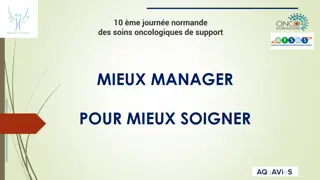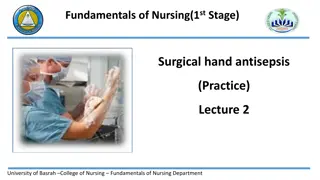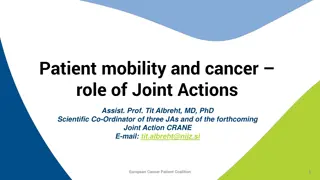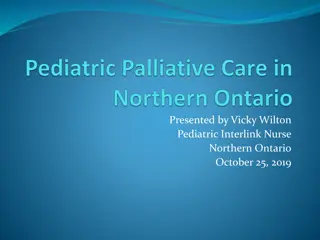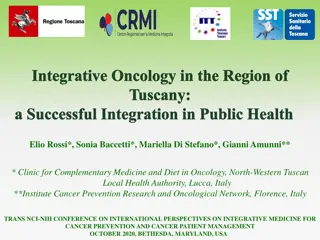Principles of Surgical Oncology and Cancer Care
Study of cancer diseases, tumor growth characteristics, types of tumors, neoplastic cell behaviors, detection methods, management approaches, and the progression of cancer stages. Key topics include surgical and non-surgical treatments, causes, diagnosis, and end-of-life care.
Download Presentation

Please find below an Image/Link to download the presentation.
The content on the website is provided AS IS for your information and personal use only. It may not be sold, licensed, or shared on other websites without obtaining consent from the author.If you encounter any issues during the download, it is possible that the publisher has removed the file from their server.
You are allowed to download the files provided on this website for personal or commercial use, subject to the condition that they are used lawfully. All files are the property of their respective owners.
The content on the website is provided AS IS for your information and personal use only. It may not be sold, licensed, or shared on other websites without obtaining consent from the author.
E N D
Presentation Transcript
Principles of Surgical Oncology Professor Maitham AL Khateeb FACS,CABS,DGS Consultant surgeon 2018
contents Definitions Characteristics of cancers Malignant transformation The growth of cancers Clinical implications Causes of cancers Management of cancers Carcinogenesis Screening of cancer Diagnosis of cancers Staging of cancers Principles of cancer surgery Removal of primary disease Removal of metastatic disease Palliative surgery Principles of non surgical treatment CHEMOTHERAPY & RADIOTHERAPY End of life care / the good death
Oncology: (Gr. onkos-tumor; logos-study) Is the study of these diseases. Tumour:is a new growth of tissue or a mass which might be inflammatory, benign or neoplastic Carcinomas: are malignant tumors that arise from epithelium. Sarcomas: are malignant tumors that arise from connective tissue. Neoplastic cells behave independently, they do not have fixed relationships to other cells and do not form organs. They are either benign or malignant. Benign means: A noninvasive growth and without metastasis. malignant means: An invasive growth with metastasis.
Doubling time of the tumor growth: (the time that the tumor takes to double in volume). This is to express the rate of tumor growth. Pathologist`s cancer: Cancers noticed at autopsy, and not clinically evident for example ( 4% of cadavers will have microscopic papillary thyroid cancer & 15% of male cadavers above 60 years will have microscopic prostatic cancer. Multicentricity: Is a feature of cancer originating at many anatomical locations. Synchronous cancer: Is another cancer that develops at the time of the initial presentation. Metachronous cancer: Is another cancer that develops later in life. Hypertrophy: increase in size of organ without increase in cell number. Hyperplasia: increase in size due to increase in cell number. Metaplasia: change in the characteristics of epithelium from which the tumor grow. Example: from Transitional to squamous (bladder cancer),from columnar to squamous ( bronchus cancer). Dysplasia: (mild, moderate & severe): Early changes of neoplastic transformation e.g. size & shape of cells & nuclei. These may revert to normal. Carcinoma in situ: neoplastic changes in cells & nuclei without invasion of extracellular matrix. Precancerous conditions: Leukoplakia may progress to carcinoma
Ductal cancer cells Normal ductal cell Ductal cancer cells breaking through the wall 5
WHAT IS CANCER ? History The name cancer comes from the Greek and Latin words for a crab, and refers to the claw-like blood vessels extending over the surface of an advanced breast cancer. The molecular biology of cancer enabling us to investigate, and, in some cases, understand, the biochemical mechanisms whereby cancer cells are formed and mediate their abnormal behaviour Cancers are now firmly based on the cellular origin of the Cancer Cancer cells are psychopaths: - They have no respect for the rights of other cells. - They violate the democratic principles of normal cellular organization - Their proliferation is uncontrolled - Their ability to spread is unbounded - Their continuous, relentless Progress destroys first the tissue and then the person In order to behave in such an unprincipled fashion, cells have to acquire a number of characteristics before they are fully malignant. No one characteristic is sufficient, and not all characteristics are necessary
Malignant transformation: _ Establish an autonomous lineage: - resist signals that inhibit growth - acquire independence from signals stimulating growth _ Obtain immortality _ Evade apoptosis _ Acquire angiogenic competence _ Acquire the ability to invade _ Acquire the ability to disseminate and implant _ Evade detection/elimination _ Genomic instability _ Jettison excess baggage _ Subvert communication to and from the environment/milieu _ Develop ability to change energy metabolism
Establish an autonomous lineage: This involves developing independence from the normal signals that control supply and demand. Cancer cells escape from this normal system of checks and balances: they grow and proliferate in the absence of external stimuli regardless of signals telling them not to do so Oncogenes, an aberrant form of the normal cellular genes, are a key factor in this process We all carry within us genetic sequences that, through mutation, can turn into active oncogenes and thereby cause malignant transformation Obtain immortality: Normal cells are permitted to undergo only a finite number of divisions. For humans, this number is between 40 and 60. The limitation is imposed by the progressive shortening of the end of the chromosome (the telomere) that occurs each time a cell divides
Cancer cells can use the enzyme telomerase to rebuild the telomere at each cell division, so there is no telomere shortening and the lineage will never die out. (The cancer cell has achieved immortality) Evade apoptosis: Apoptosis is a form of programmed cell death which occurs as the direct result of internal cellular events instructing the cell to die The cell dismantles itself neatly for disposal Normal Cells that find themselves in the wrong place normally die by apoptosis and this is an important self-regulatory mechanism in growth and development Cancer cells will be able to evade apoptosis, which means that the wrong cells can be in the wrong places at the wrong times.
Acquire angiogenic competence: The ability of a tumour to form blood vessels is termed angiogenic competence and is a key feature of malignant transformation Acquire the ability to invade: Cancer cells have no respect for the structure of normal tissues. They acquire the ability to breach the basement membrane and thus gain direct access to blood and lymph vessels using three main mechanisms to facilitate invasion: -they cause a rise in the interstitial pressure within a tissue -they secrete enzymes that dissolve extracellular matrix -they acquire motility Unrestrained proliferation and a lack of contact inhibition enable cancer cells to exert pressure directly on the surrounding tissue and push themselves beyond normal limits They secrete collagenases and proteases that chemically dissolve any extracellular boundaries that would otherwise limit their spread through tissues signals from the environment to the cytoplasm and nucleus of the cancer cells ( outside-in signaling ), these signals can induce increased motility
Acquire the ability to disseminate and implant: Once cancer cells gain access to vascular and lymphovascular spaces, they have acquired the potential to use the body s natural transport mechanisms to distribute themselves throughout the body, They also need to acquire the ability to implant Evade detection/elimination: Cancer cells are simultaneously both self and not self . Although derived from normal cells ( self ), they are, in terms of their genetic make up , behaviour and characteristics, foreign ( not self ) This may be by suppressing the expression of tumour-associated antigens Genomic instability: A cancer is a genetic ferment Cells are dividing without proper checks and balances. Mutations are arising all the time This gives rise to the phenomenon of genomic instability
Jettison excess baggage: Cancer cells are programmed to excessive and remorseless proliferation. Subvert communication to and from the environment/milieu: Providing false information is a classic military strategy. Degrading the command and control systems of the enemy is an essential component of modern warfare. Cancer cells almost certainly use similar tactics in their battle for control over their host Develop ability to change energy metabolism: Cancer cells may have to spend prolonged periods starved of oxygen in a state of relative hypoxia Compared to the corresponding normal cells, some cancer cells may be better able to survive in hypoxic conditions. Cancer cells can alter their metabolism even when oxygen is abundant
Malignant transformation: Only very rarely is a single mutation sufficient to cause cancer; multiple mutations are usually required these mutations must be acquired in a specific sequence. Cancer is usually regarded as a clonal disease. Some cancers may arise from more than one clone of cells Two mechanisms may help to sustain and accelerate the Process of malignant transformation: 1-Genomic instability: may themselves be capable of facilitating the persistence of further mutations and so the malignant transformation can be accelerated 2-Tumour-related inflammation: If a tumour provokes an inflammatory response, then the cytokines and other factors produced as a result of that response may act to promote and sustain malignant transformation.
The growth of a tumour: A tumour 10 mm in diameter it would take 30 generations to reach the threshold of clinical detectability This is an over simplification because cell loss is a feature of many tumours and, for squamous cancers, as many as 99 per cent of the cells produced may be lost, mainly by exfoliation It will, in the presence of cell loss, take many cellular divisions to produce a clinically evident tumour . Clinical implications: The majority of the growth of a tumour occurs before it is clinically detectable By the time they are detected, tumours have passed the period of most rapid growth, that period when they might be most sensitive to anti-proliferative drugs There has been plenty of time, before diagnosis, for individual cells to detach, invade, implant and form distant metastases in many patients cancer may, at presentation, be a systemic disease
Early tumours are genetically old: plenty of time for mutations to have occurred, mutations that might confer spontaneous drug resistance (a probability greatly increased by the existence of cell loss) -The rate of regression of a tumour will depend upon its age, - the rate of regression of a tumour will depend upon its growth rate at the time of treatment In its early stages, growth is exponential but, as the tumour grows, the growth rate slows. This decrease in growth rate probably arises because of difficulties with nutrition and oxygenation ,The tumour cells are in competition: not only with the tissues of the host, but also with each other THE CAUSES OF CANCER: Both inheritance and environment are important determinants of cancer development Although environmental factors have been implicated in more than 80 per cent of cases, this still leaves plenty of scope for the role of genetic inheritance:
not just the 20 per cent of tumours for which there is no clear environmental contribution but also, as environment alone can rarely cause cancer, the genetic contribution to the 80 per cent of tumours to which environmental factors contribute Knowledge about the causes of cancer can be used to design appropriate strategies for prevention or earlier diagnosis. As more is discovered about the genes associated with cancer, genetic testing and counseling will play an increasing role in its prevention. THE MANAGEMENT OF CANCER: Management is more than treatment The traditional approach to cancer concentrates on diagnosis and active treatment. Prevention is forgotten and rehabilitation ignored
Carcinogenesis: causes of cancer: 1. Chemical carcinogens; aniline dye (bladder Ca.), nickel (lung). 2. Physical carcinogens: - Ionizing radiation; leukemia,, lymphoma, thyroid & breast cancer - Ultraviolet irradiation; malignant melanoma - Sites of chronic irritation; chronic osteomyelitis, chronic ulcerative colitis, fistula in ano & in old burn scar (Margolin`s ulcer) 3. Viruses: e.g. HIV (Kaposi s sarcoma), EB virus in Burkitt`s lymphoma and Hepatitis B virus in hepatocellular carcinoma. Herpes virus in Cervix, penis, & anal cancer. 4. Other infections; Bilharzia (Bladder Ca.) & H. pylori (Stomach Ca.) 5. Tobacco; (Lung cancer & Head and neck cancer) 6. Alcohol; (Head & neck Ca., oesophageal Ca. & hepatoma. 7. Inhaled particles; Asbestos (mesothelioma) 8. Fungal and plant toxins; Aflatoxins (hepatoma) 9. Age (old age). Obesity
Prevention: 30 per cent of cancer deaths were due to tobacco use and that up to 50 per cent of cancer deaths were related to diet (smokers often have a poor diet) Estimated that cancers related to occupation accounted for less than 4 per cent of cancer deaths, and that environmental pollution accounted for less than 5 per cent of deaths. Screening: Screening involves the detection of disease in asymptomatic population in order to improve outcomes by early diagnosis. It follows that a successful screening programme( 1 ) must achieve early diagnosis, and ( 2 )that the disease has a better outcome when treated at an early stage.
slow-growing tumours are likely to be picked up by screening, whereas fast-growing tumours are likely to arise and produce symptoms in between screening rounds. Thus, screen-detected tumours will tend to be less aggressive than symptomatic tumours Because of these biases, it is essential to carry out population-based randomised controlled trials and to compare mortality rate in a whole population offered screening Diagnosis and classification: Accurate diagnosis is the key to the successful management of cancer. Precise diagnosis is crucial to the choice of correct therapy A diagnosis of cancer can confidently be made by taking tissue for pathological or cytological examination. Different tumours are classified in different ways Precise and accurate subtyping of tumours enables appropriate selection of treatment and, in turn, this is associated with better outcome.
Classification site of origin skin, larynx .. papilloma squamous cell carc. Breast, stomach .. adenoma adenocarcinoma fibrous tissue fibroma muscular tissue leimyoma, leiomyosarcoma, rhabdomyoma fatty tissue lipoma liposarcoma vascular tissue angioma bone osteoma,chodroma Tissue of origin epithelium benign malignant mesodermal fibrosarcoma rhabdomyosarcoma angiosarcoma osteogenic sarcoma, chondrosarcoma hemopoietic tissue Leukemia, multiple myeloma, lymphoma special types melanocyte neural tissue skin, eye nevus malignant melanoma brain,spinal cord astrocytoma ganglioneuroma ovary, testis teratoma glioblastoma multiforme neuroblastoma teratoma blastoderm
INVASION & METASTASIS 1. Local invasion; Occur along lines of least resistance. It is due to increased pressure by rapidly dividing cells, abnormal motility of malignant cells & the breakdown of extra cellular matrix. Lymphatics; Permeation or emboli Blood stream; Portal vein to the liver. Systemic veins to the lung. Implantation; e.g. transcoelomic through the peritoneal cavity. 2. 3. 4. Grading of the tumor: o Is based on the histological examination of the degree of differentiation of the tumor cells & mitotic index (well, moderately or poorly differentiated) Staging of the tumor: Is an estimation of the degree of spread of the tumor. It is based on clinical examination & imaging technique.
Investigations Investigations includes imaging, pathological or cytological examination. Tumor markers; CA15-3, CA27-29, CEA Diagnosis: Precise diagnosis is crucial to the choice of correct therapy. Only rarely can a diagnosis of cancer confidently be made in the absence of tissue for pathological or cytological examination
Oblique mammogram demonstrates a classic benign, partially calcified fibro adenoma with typical coarse, popcorn-like calcifications. These findings are not suspicious. scattered, well-defined, round calcifications that can be characterized as benign.
Mammogram showing linear branching calcifications in a segmental distribution (red arrow). Clustered microcalcifications such as these are highly suggestive of carcinoma, the linear branching is suggestive of a ductal lesion. Biopsy confirmed a high-grade ductal carcinoma in situ (DCIS). Compression view of a mammogram showing a high-density spiculated mass (red arrow) with heterogeneous linear clacifications in a ductal distribution (white arrows). These "casting" calcifications are characteristic of high- grade ductal carcinoma in situ [DCIS].
Investigation and staging: Staging is the process whereby the extent of disease is mapped out. It is not sufficient simply to know what a cancer is; it is imperative to know its site and extent If it is localised, then locoregional treatments is used such as surgery and radiation therapy may be curative. If the disease is widespread, then, although such local interventions may contribute to cure, they will be insufficient, and systemic treatment, for example with drugs or hormones ,will be required. The International Union against Cancer (IUCC) is responsible for the TNM (tumour, nodes, metastases ) staging system for cancer., This system is compatible with, and relates to, the American Joint Committee on Cancer (AJCC) system for stage grouping of cancers
Benefit of staging 1. 2. 3. Gives an estimate of prognosis Useful in planning treatment Helps in comparison of outcome in different centers Types of staging: Manchester staging of breast cancer: Stage 1. Tumor localized to the breast, <2cm Stage 2. Tumor 2-5cm with mobile axillary lymph nodes same side Stage 3. Tumor size > 5cm with fixed axillary lymph nodes Stage 4. Tumor with distant metastasis
TNM classification Stage T = tumor No palpable tumor T1 < 2cm N = node M = metastasis TIS N0 = no nodes M0 I N0 = no nodes N1 = mobile axillary lymph nodes = II T2 (2-5cm) = T3 N2 = fixed lymph nodes = IIIa IIIb Any size invading skin + N3 (supra- Clavicle ipsilateral lynph nodes T4 = Any Any M = 1 IV
Therapeutic decision making and the multidisciplinary team As the management of cancer becomes more complex, it becomes impossible for any individual clinician to have the intellectual and technical competence that is necessary to manage all the patients presenting with a particular type of tumour Teams should Not only be multidisciplinary, they should be multiprofessional Members of the multiprofessional team _ Site-specialist surgeon _ Surgical oncologist _ Plastic and reconstructive surgeon _ Clinical oncologist/radiotherapist _ Medical oncologist _ Diagnostic radiologist _ Pathologist _ Speech therapist _ Physiotherapist _ Prosthetic specialist _ Clinical nurse specialist (rehabilitation, supportive care) _ Palliative care nurse (symptom control, palliation) _ Social worker/counsellor _ Medical secretary/administrator _ Audit and information coordinator
Principles of cancer surgery: For most solid tumours, surgery remains the definitive treatment and the only realistic hope of cure However, surgery has several roles in cancer treatment including: - Diagnosis - Removal of primary disease - Removal of metastatic disease - Palliation -Prevention - Reconstruction Diagnosis and staging : In most cases, the diagnosis of cancer has been made before definitive surgery is carried out but, occasionally, a surgical procedure is required to make the diagnosis. This is particularly true of patients with malignant ascites where laparoscopy has an important role in obtaining tissue for diagnosis.
Types of biopsy 1. FNAB is operator dependent . 2. True-cut biopsy or Core needle biopsy Multiple tissue samples FNAC (fine needle aspiration cytology) Easy, inexpensive, no preparation. Not reliable in distinction between in situ & invasive ductal carcinoma.
3-Incisional biopsy Only part of the tumor is removed for histopathological study - It is done when the tumor is large - It is rarely performed nowadays - It is done under local or general anaesthesia
4-Excisional biopsy Most common biopsy procedure The entire lump is taken out using a small incision Send the specimen for histopathological study & report
Laparoscopy is also widely used for the staging of intra-abdominal malignancy, particularly lower esophageal and gastric cancer Laparoscopic ultrasound is a particularly useful adjunct for the diagnosis of intrahepatic metastases Until recently, staging laparotomy was an important aspect of the staging of lymphomas which is now replaced by laparoscopic technique Removal of primary disease: Radical surgery for cancer: - involves removal of the primary tumour and - as much of the surrounding tissue and - lymph node drainage as possible in order not only to ensure local control but also to prevent spread of the tumour through the lymphatics. that ultraradical surgery probably has little effect on the development of metastatic disease It is important, however, to appreciate that high-quality, meticulous surgery taking care not to disrupt the primary tumour at the time of excision is of the utmost Importance in obtaining a cure in localised disease and preventing local recurrence
Removal of metastatic disease: In certain circumstances, surgery for metastatic disease may be appropriate. This is particularly true for liver metastases arising from colorectal cancer, With multiple liver metastases, it may still be possible to take a surgical approach by using in situ ablation with cryotherapy or radiofrequency energy Palliation: In many cases, surgery is not appropriate for cure but may be extremely valuable for palliation. A good example is the patient with a symptomatic primary tumour who also has distant metastases. In this case: Removal of the primary may improve the patient s quality of life, but will have little effect on the ultimate outcome. Other examples include bypass procedures, such as an ileotransverse anastomosis to alleviate symptoms of obstruction caused by an inoperable caecal cancer Or bypassing an unrespectable carcinoma at the head of the pancreas by cholecysto- or choledochojejunostomy to alleviate jaundice.
Non surgical treatment of cancers In patients with documented distant metastatic disease, chemotherapy is usually the primary modality of therapy. Chemotherapy is rarely sufficient to cure cancer. Chemotherapy is often a palliative intervention Include; 65% are Cytotoxic drugs, 15% are hormonal therapies and 15% are designed to interact with specific molecular targets so called targeted therapies. Types of chemotherapeutic and biological agents : 1. Drugs that interfere with mitosis (Vincristine, vinblastine) in lymphoma 2. Drugs that interfere with DNA synthesis (anti-metabolites) e.g. Fluorouracil (5- FU) in breast cancer & Gastrointestinal cancer 3. Drugs that damage DNA (Mitomycin C) in bladder & Head and neck cancer 4. Hormones; (Tamoxifen) Blocks oestrogen receptors in Breast cancer & Head and neck cancer. Anastrazole (An aromatase inhibitor) blocks post- menopausal (non-ovarian) oestrogen production in breast cancer. 5. Antibodies directed to cell surface antigens (Trastuzumab) Antibody directed against HER2 receptor in breast cancer 6. Immunological mediators (Interferon alpha-2b) in melanoma & renal carcinoma Adjuvant therapy can be administered after surgery (postoperative chemotherapy) Neoadjuvant chemotherapy before surgery (preoperative chemotherapy)
Principles underlying the non-surgical treatment of cancer : the treatment should be selectively toxic to the tumour and, as far as possible, should spare the normal tissues from damage It is this simple principle that decides both the selection of agents used to treat cancer and the schedules employed to deliver them. - Chemotherapy is systemic treatment - surgery is mainly a local treatment - Radiotherapy is usually local or locoregional, but can, as in radioiodine therapy for thyroid cancer, be systemic. Radiotherapy: Radiation can, both directly and indirectly, influence gene expression, These changes in gene expression are responsible for a considerable proportion of the biological effects of radiation upon tumours and normal tissues, In this sense: radiotherapy is a precisely targeted form of gene therapy for cancer.
Fractionated radiotherapy selectively spares late, as opposed to immediate effects of radiotherapy. For any given total dose, the smaller the dose per treatment (the larger the number of fractions), the less severe the late effects will be. the greater the number of fractions of daily treatment, the longer the overall treatment time and the greater the opportunity for the tumour to proliferate during treatment Chemotherapy and biological therapies : Selective toxicity is the fundamental principle underlying the use of chemotherapy in clinical practice chemotherapy is rarely sufficient to cure cancer Chemotherapy is often a palliative rather than a curative intervention There are now over 95 different drugs licensed by the US Food and Drug Administration (FDA) for the treatment of cancer.
Over 50 per cent of these agents have been licensed since 1990: The kinase inhibitor will only be effective in patients with melanoma cetuximab is only effective in patients with colorectal cancer imatinib is particularly effective in patients with gastrointestinal stromal tumours (GIST) The next decade will see a major shift in the medical management of cancer from cell destruction to cellular reprogramming, but the longer-term consequences of such sophisticated manipulations may be uncertain and unpredictable. Principles of combined treatment: Cytotoxic drugs are rarely used as single agents radiotherapy and chemotherapy are often given together The choice of drugs for combination therapy is based upon three main principles: (1) use drugs active against the disease (2) use drugs with distinct modes of action (3) use drugs with non-overlapping toxicities it may be possible to obtain a truly synergistic effect
It is inadvisable to combine drugs with similar adverse effects; combining two highly myelosuppressive drugs may produce an unacceptably high risk of neutropenic sepsis In considering the combination of radiotherapy and chemotherapy, radiation could be considered as just another drug. Palliative therapy: The distinction between palliative and curative treatment is not always clear cut, Five-year survival is not necessarily equal to cure the distinction between curative and palliative therapy seems somewhat arbitrary Palliative treatment has as its goal the relief of symptoms Palliative medicine in the twenty-first century is about far more than optimal control of pain: its scope is wide, Its impact immense
End-of-life care : End-of-life care is distinct from palliative care. Patients treated palliatively may survive for many years end-of-life care concerns the last few months of a patient s life The concept of the good death has been embedded in many cultures over many centuries But it is not an accepted practice and not legally permitted practice in our community and country( the good death ).





